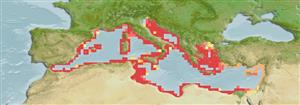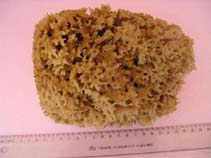Hippospongia communis (Lamarck, 1813)
Honey comb| Native range | All suitable habitat | Point map | Year 2050 |

|
| This map was computer-generated and has not yet been reviewed. |
| Hippospongia communis AquaMaps Data sources: GBIF OBIS |
Classification / Names Common names | Synonyms | CoL | ITIS | WoRMS
Demospongiae | Dictyoceratida | Spongiidae
Environment: milieu / climate zone / depth range / distribution range Ecology
Sessile; depth range 5 - 80 m (Ref. 363). Subtropical; 46°N - 25°N, 19°W - 36°E
Distribution Countries | FAO areas | Ecosystems | Occurrences | Introductions
Eastern Central Atlantic and the Mediterranean.
Length at first maturity / Size / Weight / Age
Maturity: Lm ? range ? - ? cm Max length : 30.0 cm WD male/unsexed; (Ref. 363)
Short description Morphology
Massive sponge; on surface equipped with conules very irregularly dispersed. A thin and generally smooth ectosome covers the surface gaps. Sponge: traversed great gaps méandriformes. Rare primary fibers: 0.0060 to 0.01 cm diameter; formed by the anastomoses of several fibers at their end in the conules; and containing foreign bodies. Secondary fibers: 0.0025 to 0.003 cm diameter. Coloring: darkish gray with yellowish on the surface, often brown white orange inside (Ref. 363).
Importance: It is the principal species currently exploited. The essence of the production comes from Tunisia. It is used for the domestic uses, the toilet and certain industries (Ref. 363). Common between 5 and 30 m of depth, would go down up to 80 m to Libya (Ref. 363).
Life cycle and mating behavior Maturity | Reproduction | Spawning | Eggs | Fecundity | Larvae
Members of the class Demospongiae are hermaphroditic. Life cycle: The zygote develops into parenchymella larva (free-swimming) before settling down on a substrate where it grows into a young sponge.
Main reference
References | Coordinator | Collaborators
Vacelet, J. 1987. (Ref. 363)
IUCN Red List Status (Ref. 130435)
CITES status (Ref. 108899)
Not Evaluated
CMS (Ref. 116361)
Not Evaluated
Threat to humans
Harmless
Human uses
Fisheries: highly commercial
| FishSource |
Tools
More information
Internet sources
BHL | BOLD Systems | CISTI | DiscoverLife | FAO(Publication : search) | Fishipedia | GenBank (genome, nucleotide) | GloBI | Gomexsi | Google Books | Google Scholar | Google | PubMed | Tree of Life | Wikipedia (Go, Search) | Zoological Record
Estimates based on models
Preferred temperature
(Ref. 115969): 15.2 - 21.6, mean 18.8 (based on 158 cells).
Price category
(Ref. 80766):
Unknown.



